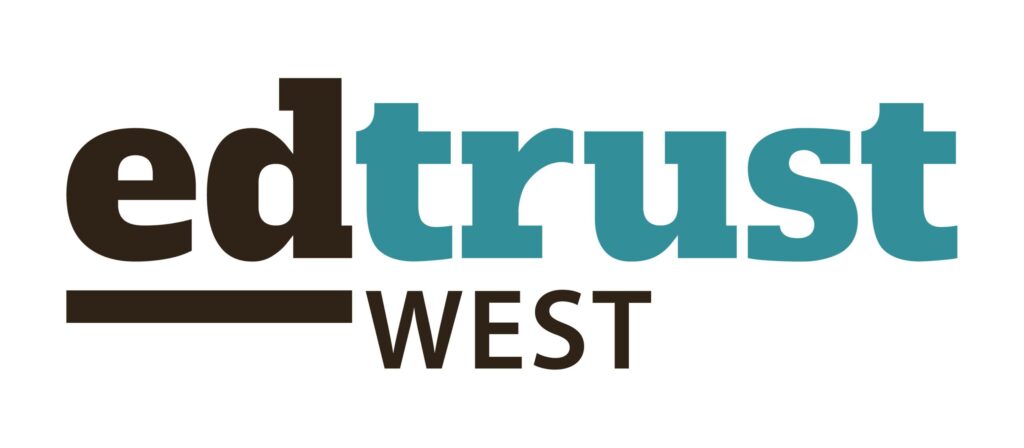OAKLAND, CA (January 15, 2010) As California signs its application for federal Race to the Top (RTTT) funding, many recognize that we may never achieve the excellence the Obama administration seeks without focusing our proposal squarely on equity for low-income students and students of color.
Indeed, Secretary of Education Arne Duncan has made it clear that these RTTT grants will reward states not only for bold reforms proposed for the future but also for past progress in narrowing gaps in student achievement. But narrowing those gaps once and for all requires close, consistent monitoring not just of whether gaps are narrowing but how.
A new report released by The EdTrust, Gauging Gaps: A Deeper Look at Student Achievement, provides a new lens with which to look at NAEP data that moves us from a single pronged approach to a multi-pronged review of California’s achievement. And while it doesn’t tell us much that is new – California’s students continue to make slow, incremental progress and huge gaps remain – when put in the context of our Race to the Top competitiveness, it signals cause for concern.
Gauging Gaps offers four criteria for examining a state’s progress in closing achievement gaps: Simple Gap Narrowing, Progress for All, Gap Size and Group Comparisons across Jurisdictions. Examining these four criteria and making comparisons across states, California has one of the worst track records in closing achievement gaps in the nation:
- GAP CLOSING: Have achievement gaps closed since 2003?
- Since 2003, California has made no significant progress in closing achievement gaps between African-American, Latino, and low-income students and their white and higher-income peers.
- Meanwhile, states with similar demographics including Florida and New York have made significant progress in closing gaps.
- GAP SIZE: How large are the achievement gaps?
- California has significantly larger Latino-White achievement gaps in 4th grade reading than 26 other states; and Latino-White gaps in 8th grade math significantly larger than 23 states.
- The Latino-White gap in 4th grade reading and math, and 8th grade math in California is significantly larger than the national average.
- ACROSS JURISDICTIONS: How do California’s NAEP scores compare to other states?
- Fourty-four states perform significantly higher than California on the NAEP 2009 4th grade mathematics and 8th grade reading assessment for all students.
- California is amongst the bottom 5 states in group performance across grade levels and subjects, where low-income students and students of color typically performed lower than their peers elsewhere in the nation.
- Latino and low-income students in California perform significantly lower in 4th grade reading and math than the national average for their subgroup.
- In 8th grade reading, all subgroups (African-American, white, Latino, low-income, high-income) in California perform significantly lower than the national average for their counterparts, while African-American and Latino 8th graders in states like Texas, Delaware, and Virginia, perform significantly higher than the national average.
And while California does demonstrate some improvement in achievement scores over time, here too we see some subgroups and grade levels being left behind:
- PROGRESS FOR ALL: Have all subgroups improved their scores since 2003?
- In 4th grade, reading and math performance for both low-income and Latino students improved significantly from 2003 to 2009.
- However, this improvement is not seen among African-American students, who have not made significant gains in 4th or 8th grade reading or math since 2003.
- There has been no significant improvement in 8th grade reading since 2003 for any of the subgroups (African-American, white, Latino, low-and high-income).
“These data are not new, but seen through the Race to the Top lens, they must push state leaders to use this unprecedented opportunity to fix these persistent and pervasive gaps,” said Arun Ramanathan, Executive Director of The EdTrust—West. “As our state leaders move forward in the Race to the Top Competition, eliminating these achievement gaps must be our top priority.”
Teacher quality, expectation levels, and resources are prime factors in student achievement. In the high-poverty schools that serve the majority of our students of color and second language learners, California continues to give less of everything we know matters most in education and the gaps in achievement persist. Regardless of whether California wins RTTT, policymakers should implement bold and innovative reforms as ways to eliminate our persistent achievements gaps.
- Teacher Quality: (1) Use multiple measures to assess the effectiveness of teachers, (2) Implement district-wide policies that will ensure the equitable distribution of high-quality teachers, and incentive pay to improve teacher quality in hard-to-staff schools, (3) Change personnel policies that rely on years of experience as the only factor determining tenure and layoffs.
- Resources: Despite California’s fiscal crisis, there must be significant attention paid to reallocating resources to ensure the neediest students and schools have the resources they need to close the achievement gap.
- Accountability Systems: In the planned revisions to the Annual Performance Index (API), California must (1) take into account not only student growth, but also a comprehensive measure of how well schools and districts are addressing achievement gaps (e.g., gap closing, gap size, progress for all groups, and comparisons across schools/districts), and (2) Include college readiness indicators (A-G completion rate, EAP success) in high school accountability measures.
“The Race to the Top competition affords us a chance to not only tout high standards but develop innovative strategies to actually ensure that all students have access to the quality education they need to achieve these standards,” continued Ramanathan. “But first we must get honest about why some students are given the opportunity to achieve and why others are left to languish.”
To read the full report, click here.
Persistent Achievement Gaps May Impeded California’s Efforts to Win the Race to the Top
###

